🧬 AP Biology Unit 2
10-13% AP Weighting
2.1 - Cell Structure: Sub-cellular Components
2.2 - Cell Structure and Function
2.3 - Cell Size
2.4 - Plasma Membranes
2.5 - Membrane Permeability
2.6 - Membrane Transport
2.7 - Facilitated Diffusion
2.8 - Tonicity and Osmoregulation
2.9 - Mechanisms of Transport
2.10 - Cell Compartmentalization
2.11 - Origins of Cell Compartmentalization
2.1-2.3, 2.10-2.11 - Cell Structure
Click Here for a video on cell organelles and general structure.
Click Here for a video on intercellular junctions.
“Cyte” is a prefix for cell. All cells have a cell membrane, DNA, and ribosomes. Eukaryotic cells are bigger than prokaryotic cells. Cells have compartments made of plasma membranes. This came to be based on the theory of endosymbiosis, where a cell “ate” another cell, but did not digest it, leading to a symbiotic relationship, such as between mitochondria and our cells.
Cells need a high surface area to volume ratio for diffusion. Bigger cells has a smaller surface area/volume ratio. 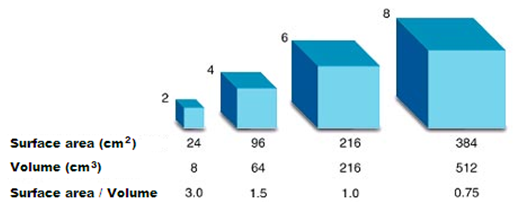
Organelles
Nucleus
Nucleus contains DNA, is double membrane bound, and is attached to the rough ER. Within the nucleolus is where ribosomal RNA (rRNA) (Ribosome) is created.
Ribosome
Ribosomes make proteins. Some are free, some are bound to the rough ER.
Lysosome
Lysosomes are sacs of hydrolytic enzymes that digest macromolecules. The enzymes work best at a pH of 5. If they get out into the rest of the cells it will denature. However, if enough escape, apoptosis (suicide) will occur. Lysosomes are how cells kill themselves.
Vesicles
Vesicles are transport organelles, like bags.
Endoplasmic Reticulum
The ER makes for half the membranes in the cell.
The smooth ER does not have ribosomes attached to it. It makes lipids for the body. The enzymes in the smooth ER break down toxins like barbiturates and alcohol.
The rough ER has ribosomes, so it makes membranes with proteins in them, like glycoproteins (marker protein).
Golgi Apparatus
The Golgi Apparatus is the center of manufacturing, warehousing, sorting, and shipping. The Golgi Apparatus can modify different things. (Proteins, etc) It looks like a bunch of pita bread. The Cis side is for receiving, the trans side is for delivery.
Vacuoles
Vacuoles are used for storage. They retain water and control water pressure, which can keep plant cells from lysing.
Mitochondria
Mitochondria is the powerhouse of the cell (sorry had to) and makes ATP. It is semi-autonomous.
Chloroplasts
Chloroplasts do photosynthesis. It is semi-autonomous.
Both mitochondria and chloroplasts have DNA and replicate themselves. They also both make ATP. They are double membrane bound.
Peroxisomes
Peroxisomes help in performing various metabolic functions. Some break down fatty acids and others detoxify the cell from things like alcohol. An intermediate product of this process is hydrogen peroxide, even though it is poisonous. So, it has an enzyme (catalase) that turns H2O2 into water.
Other Cell Structures
Endomembrane System
The endomembrane system is a system of many organelles which are connected by vesicles.
Nuclear envelope
Endoplasmic Reticulum
Golgi apparatus
Lysosome
Plasma Membrane
Vacuoles
Cytoskeleton
The cytoskeleton provides structural support to the cell. It is dynamic, meaning can be disassembled and then reassembled elsewhere. It created a geodesic frame. It is comprised of three fibers
Microtubules (Cilia and Flagella are also made of this)
Microfilaments
Intermediate Filaments
Motor Proteins
Motor Proteins are small proteins that use ATP to move things around the cell along the cytoskeleton. Adding and then removing ATP causes their structure to change and it “takes a step.”
Look at that little guy go :D
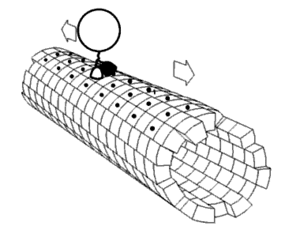
Intercellular Junctions
Intercellular Junctions help cells connect and communicate with each other.
Tight junctions cannot be passed through, they help cells create a tight wall.
Gap junctions allow intercellular materials to move from one cell to another.
Desmosomes physically anchor cells to one another.
Plasmodesmata connect plant cells by connecting the membranes through holes in the cell wall.
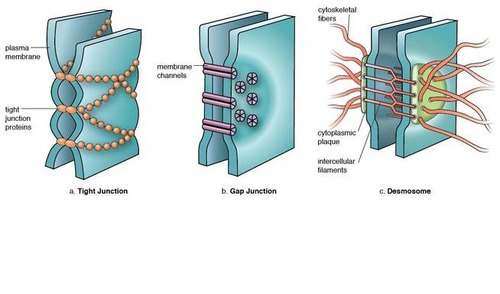
Extracellular Matrix
The extracellular matrix is outside of the cell. It helps with support, adhesion, movement, regulation, and protection similar to cell walls.
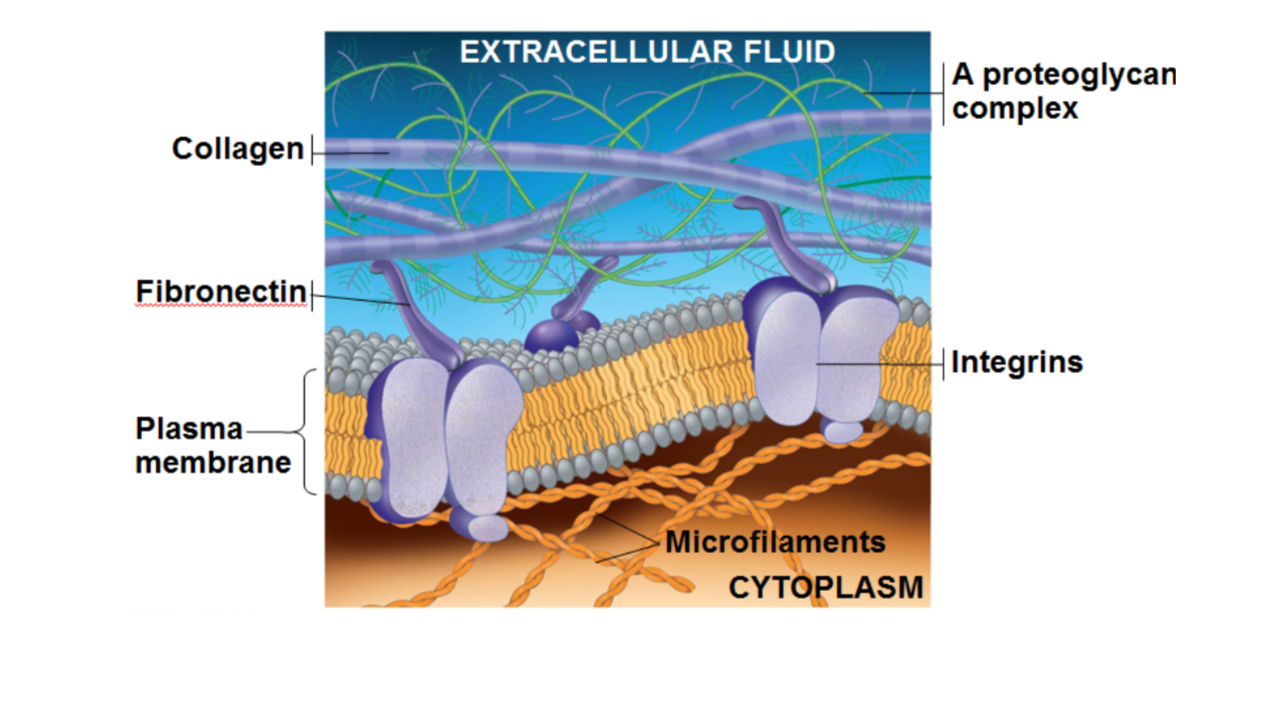
2.4-2.5 - Plasma Membrane
Click Here for a video explaining this the Plasma Membrane and it’s components.
Cell membranes are fluid, like a crowd of people. Parts can move around even though they are tightly packed. It is composed of a Phospholipid bilayer with a hydrophobic and hydrophilic end. It is selectively permeable, it can, for most things, decide what can travel through it.
Water, Oxygen, and Carbon Dioxide can always go through a plasma membrane, cells cannot prevent this flow.

On the cell membrane there can be proteins. Integral proteins are proteins permanently embedded in the membrane. One type of integral protein, transmembrane proteins, go all the way through the membrane. Integral proteins help with attaching the cytoskeleton to the extracellular matrix, intercellular joining, cell-cell recombination, enzymatic activity, and single transduction. Peripheral proteins are attached to the outside of the cells or temporarily embedded in the cell membrane (do not go all the way through!)
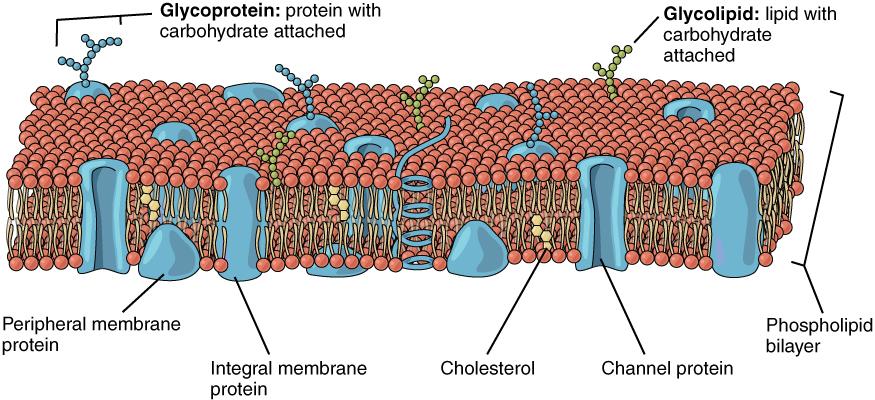
2.6-2.9 - Transport
Click Here for a video explaining Diffusion.
Click Here for a video explaining Osmosis and Water Potential
Click Here for a video explaining other forms of transport (often with proteins)
Understanding the basics of transport is important in AP Biology. On the AP test, they often ask questions about pathways you don’t know, and aren’t expected to know. You will need to be able to apply your understand of transport to understand how this pathway generally works. The Sodium-Potassium pump is shown on the AP exam, so it’s helpful to learn how it works. Here is a video for that. I will be uploading a note with an overview of the AP exam and include several other common examples for the AP exam, so you don’t just have to rely on application for some questions.
Diffusion is the random, passive (not energy requiring) movement of molecules across a membrane. They will flow from high to low concentration. Other factors such as higher temperatures or a higher difference in concentrations increase the rate of diffusion.

Hypotonic means there are less solutes than in the surrounding environment. Isotonic means there are an equal concentration of solutes compared to the surrounding environment. Hypotonic means there are more solutes than the surrounding environment.
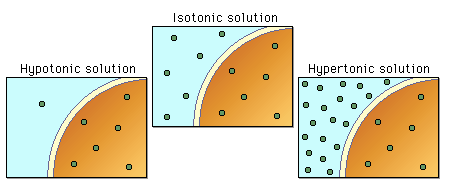
Osmosis is the random, passive movement of water molecules across the plasma membrane. It goes from high to low concentration of solutes, or from hypotonic to hypertonic. In simpler terms, water wants to have an equal amount of solute concentrations, so it will actually flow to an area of more water in order to even the concentration. This happens because water can flow through certain barriers that larger molecules cannot, so to even the concentration, water must move.

A plant cell prefers a hypotonic environment where it is turgid and pushes against its cell wall. Animal cells prefer isotonic environments where they are flaccid. Plant cells will plasmolyze and die due to their cell walls if they are in a hypertonic environment. Plant cells don’t lyse/overexpand due to their cell walls.
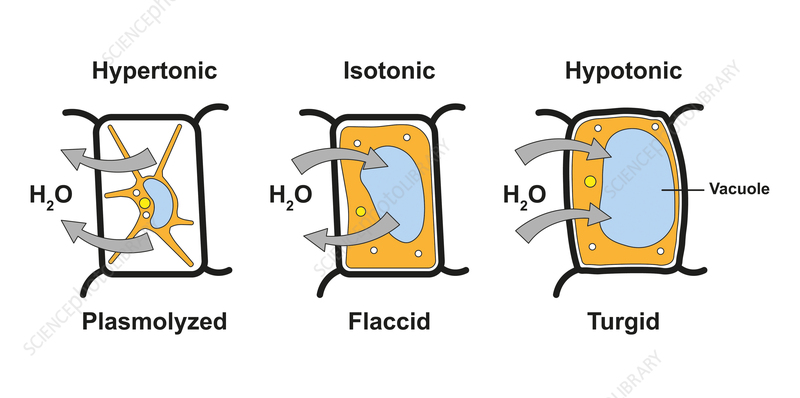
Water Potential Equation
Ψ - the symbol for water potential, aka where the water is going to go
The formula for water potential is Ψ = Ψs - Ψp
Ψp Is the pressure potential, and Ψs is the solute potential.
Solute Potential Equation
ΨS = -iCRT
i is the ionization constant, which is 1.0 mole for sucrose. C is the molar concentration. R is pressure constant. T is the temperature in Kelvin, which is Celsius + 273. Pure water has 0 moles of glucose, (0 mole concentration) it is as hypotonic as possible..
Other Forms of Transport (Often with Proteins)
Cells use proteins for moving larger molecules or higher amounts of proteins through the cell membrane. Water, Oxygen, and Carbon Dioxide are the only molecules that can flow through the cell membrane on their own. All other molecules require a protein or another form of transport, like exocytosis or endocytosis; they can’t pass through the phospholipid bilayer.
Facilitated Diffusion - The passive movement of molecules down its concentration gradient.
Channel Proteins - Allows for fast transport (they are like a door)
Active Transport - Requires a cell to use its own metabolic energy (ATP). It pumps against the concentration gradient (low -> high)

Cotransport - A special protein that can transport 2 different types of molecules simultaneously. For example, in the scenario below, the H+ ions ‘want’ to go to the lower concentration within the cell. We take advantage of this and force it to ‘bring along’ a sucrose molecule, which would otherwise require an energy input. Cells do have to use energy to pump out the H+ ions, but it is less than the energy required to pump sucrose.
Exocytosis + Endocytosis - the transport of large molecules in/out of a cell with a vesicle

Phagocytosis - “cellular eating”
Pinocytosis - “cellular drinking”
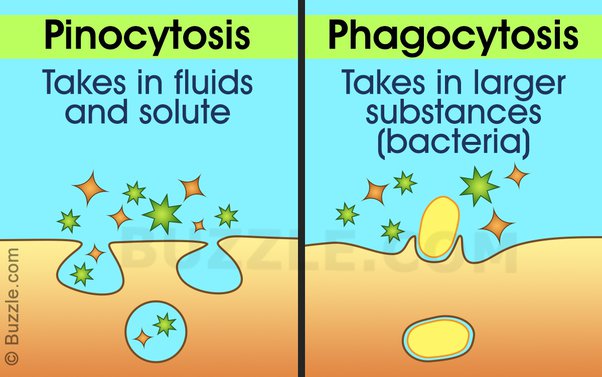
Movement in Plants
Plants transport sugar, water, and nutrients through their xylem and phloem. Xylem transports water, called “xylem sap.” Phloem transports sugars and nutrients, called “phloem sap.” The movement of sugar in phloem is called translocation. The “vein” of a plant, a vascular bundle, is like a hose filled with smaller hoses. Vascular bundles have both xylem and phloem.
Xylem is made of dead cells stacked on top of each other, called sclerenchyma. Xylem flows from roots to shoots.
Phloem is made of (living) parenchyma. The cells need to be living because translocation requires pumping. The parenchyma cells in phloem are called sieve tubes and have no organelles. They all have a companion cell which they share the organelles with. Sieve tubes are stacked on top of each other and have porous sieve plates on each end where they connect to the next tube. This allows nutrients to slow through them. Phloem flows from source to sink. Tubers are used as a source when necessary.
In symplast transport, things move through the plasmodesmata. It is the simplest way. (Symplast way) The Apoplast method is going through cell walls and cell membranes and can only be done by certain molecules. (O2, CO2, H2O)
Plants have proton (H+) pumps to pump protons from high to low concentration with active transport. The hydrogen ions want to flow back to the lower concentration. Cells take advantage of this by using a protein to do cotransport to pump sugars against their concentration gradient using the H+ ions, bringing both to the other side of the cell membrane.
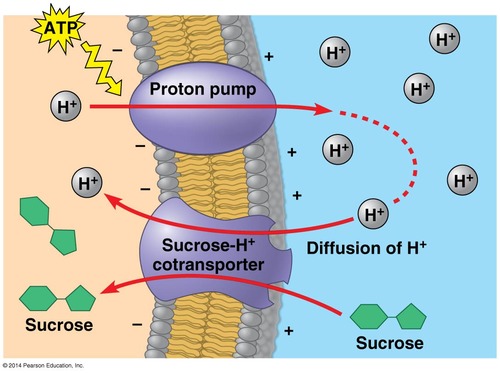
Transpiration is the movement of water through a plant and its xylem, from absorption to evaporation. Plants lose large amounts of water in their leaves through transpiration’s bulk transport.
Root pressure is a weak form of transport used by smaller plants. Roots are hypertonic, so water will flow into them. The increase of water pushes itself further up the plant and eventually out the leaves. This only works for shorter distances.
Negative pressure “pulls” while (positive) pressure “pushes.” One example of negative pressure is the pulling back of a syringe with the tip in water. Water is pulled in, despite gravity wanting to keep it down. Tension is a form of negative pressure. Plants utilize negative pressure to move water. When water is removed, the surface of the water wants to flatten back out, it doesn't want a “hole” in the surface. This flattening pulls on water, pulling up water molecules to fill the gap and forcing everything upwards. It is similar to pulling on someone in a chain of people holding hands it pulls everyone.
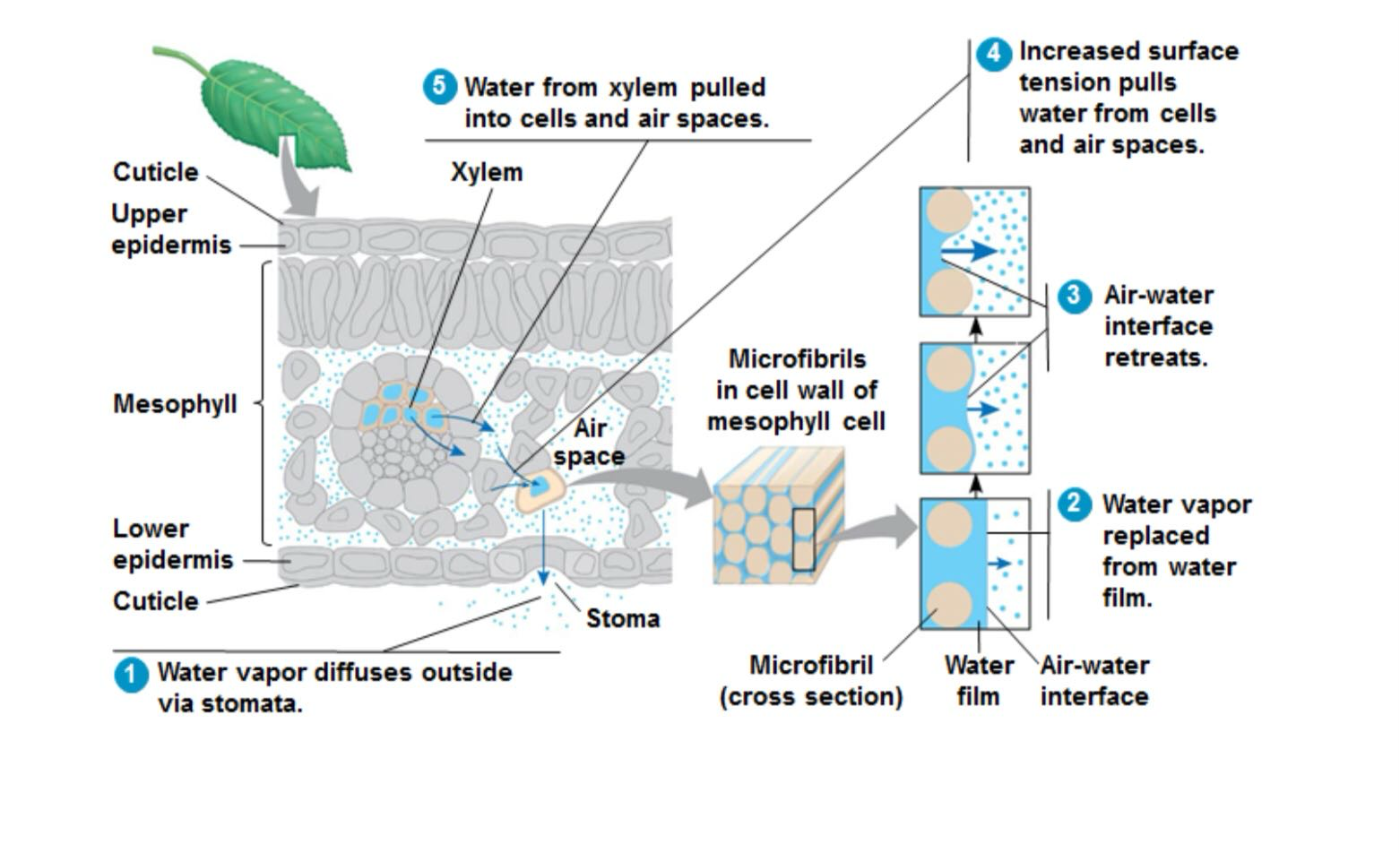 Translocation: Sugar is created in leaves in bulk, which causes a high pressure. This also pulls water to that area, making an even higher pressure. This pressure pushes the sugars through the phloem in an attempt to lower the pressure. It is then close to a sink, where it can be actively pumped in.
Translocation: Sugar is created in leaves in bulk, which causes a high pressure. This also pulls water to that area, making an even higher pressure. This pressure pushes the sugars through the phloem in an attempt to lower the pressure. It is then close to a sink, where it can be actively pumped in.